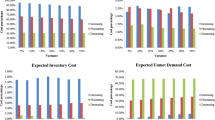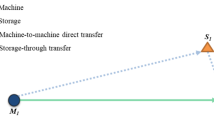Abstract
Demand fulfillment and capacity utilization directly affects customer satisfaction, market growth, and the profitability of the company in the semiconductor industry. These characteristics boost the significance of allocating various customer demands to a number of wafer fabrication facilities (fabs) with different capacity configurations. Before volume production, the introduction of new semiconductor product, namely new tape-out (NTO), requires extremely sophisticated and lengthy qualification with high-cost masks and pilot runs in the qualified fabs. Thus, the NTO allocation will affect future product mix of the qualified fabs, and the flexibility to fulfill the volume demands of the allocated NTOs in the corresponding fabs. This research aims to construct a two-stage stochastic programming (2-SSP) demand fulfillment model. The first stage considers NTO allocation decisions to a number of qualified fabs before the corresponding demand volume is realized. The second stage allocates the capacity to fulfill demand requirements based on the results of four options of capacity reconfiguration: (1) qualifying a product to more than one fab (share); (2) physically transferring a set of masks for a product from one fab to another, where a requalification is required (transfer); (3) moving tools from under-loaded fabs to over-utilized fabs (backup); and (4) utilizing different technologies to capacity inside a fab to support the technology with insufficient capacities (exchange). Both the share and transfer options require long lead time for qualification, whereas the backup and exchange options can be accomplished within a planned timeframe. A numerical study based on real settings is conducted to estimate the validity of the proposed 2-SSP model via values of stochastic solution (VSS) and expected values of perfect information (EVPI). The results showed the benefits of adopting 2-SSP models, especially in an environment with high-demand fluctuation. Furthermore, the proposed 2-SSP can provide near-optimal solutions similar to those of deterministic models with perfect information.



Similar content being viewed by others
References
Ahmed S, Sahinidis N (2003) An approximation scheme for stochastic integer programs arising in capacity expansion. Oper Res 51(3):461–471
Barahona F, Bermon S, Günlük O, Hood S (2005) Robust capacity planning in semiconductor manufacturing. Nav Res Logist 52(5):459–468
Bard JF, Srinivasan K, Tirupati D (1999) An optimization approach to capacity expansion in semiconductor manufacturing facilities. Int J Prod Res 37(15):3359–3382
Bilgin S, Azizoglu M (2009) Operation assignment and capacity allocation problem in automated manufacturing systems. Comput Ind Eng 56:662–676
Birge JR, Louveaux F (1997) Introduction to stochastic programming. Springer, New York
Bitran GR, Tirupati D (1989) Capacity planning in manufacturing networks with discrete options. Ann Oper Res 17:119–136
Chen ZL, Li S, Tirupati D (2002) A scenario-based SP approach for technology and capacity planning. Comput Oper Res 29(7):781–806
Chien CF, Zheng J (2011) Mini-max regret strategy for robust capacity expansion decisions in semiconductor manufacturing. J Intell Manuf. doi:10.1007/s10845-011-0561-1
Chien CF, Chen Y, Peng J (2010) Manufacturing intelligence for semiconductor demand forecast based on technology diffusion and product life cycle. Int J Prod Econ 128(2):496–509
Christie RME, Wu SD (2002) Semiconductor capacity planning: stochastic modeling and computational studies. IIE Trans 34(2):131–143
Chung SH, Huang CY, Lee AHI (2006) Capacity allocation model for photolithography workstation with the constraints of process window and machine dedication. Prod Plan Control 17:678–688
Fleischmann B, Ferber S, Henrich P (2006) Strategic planning of BMW’s global production network. Interfaces 36(3):194–208
Geng N, Jiang Z (2009) A review on strategic capacity planning for the semiconductor manufacturing industry. Int J Prod Res 47(13):3639–3655
Geng N, Jiang Z, Chen F (2009) Stochastic programming based capacity planning for semiconductor wafer fab with uncertain demand and capacity. Eur J Oper Res 198(3):899–908
Huang K, and Ahmed S (2005) The value of multi-stage stochastic programming in capacity planning under uncertainty. Online http://www2.isye.gatech.edu/sahmed/SCPP9.pdf. Accessed 10 March 2011
Inman RR, Gonsalvez DJA (2001) A mass production product-to-plant allocation problem. Comput Ind Eng 39(3):255–271
Jordan WC, Graves SC (1995) Principles on the benefits of manufacturing process flexibility. Manage Sci 41(4):577–594
Kauder S, Meyr H (2009) Strategic network planning for an international automotive manufacturer. OR Spectr 31(3):507–532
Kim S, Uzsoy R (2008) Exact and approximate algorithms for capacity expansion problems with congestion. IIE Trans 40:1185–1197
Leachman RC, Ding SW, Chien CF (2007) Economic efficiency analysis of wafer fabrication. IEEE Trans Autom Sci Eng 4(4):501–512
Mackie KR, Cooper CD (2009) Landfill gas emission prediction using Voronoi diagrams and importance sampling. Environ Model Softw 24:1223–1232
Moore GE (1965) Cramming more components onto integrated circuits. Electronics 38(8):114–117
Mouli C, Winstead CH (2007) Tapeout Execution System (TES), a key enabler of DFM/co-optimization. International Symposium on Semiconductor Manufacturing (ISSM) DM-O-165
Pahl J, Voß S, Woodruff DL (2007) Production planning with load dependent lead times an update of research. Ann Oper Res 153(1):297–345
Wang KJ, Wang SM, Yang SJ (2007) A resource portfolio model for equipment investment and allocation of semiconductor testing industry. Eur J Oper Res 179(2):390–403
Wu JZ, Chien CF (2008) Modeling strategic semiconductor assembly outsourcing decision based on empirical settings. OR Spectr 30(3):401–430
Wu SD, Erkoc M, Karabuk S (2005) Managing capacity in the high-tech industry: a review of literature. Eng Econ 50(2):125–158
Acknowledgments
This study was partially supported by National Science Council, Taiwan (NSC97-2221-E-007-111-MY3; NSC100-2410-H-031-011-MY2; NSC99RA13).
Author information
Authors and Affiliations
Corresponding author
Rights and permissions
About this article
Cite this article
Chien, CF., Wu, JZ. & Wu, CC. A two-stage stochastic programming approach for new tape-out allocation decisions for demand fulfillment planning in semiconductor manufacturing. Flex Serv Manuf J 25, 286–309 (2013). https://doi.org/10.1007/s10696-011-9109-0
Published:
Issue Date:
DOI: https://doi.org/10.1007/s10696-011-9109-0




